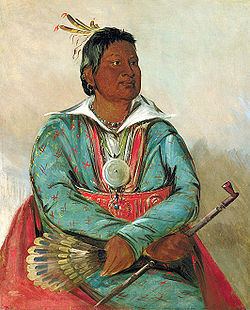Preceded by Hoomastubbee Role Chief Name Mushulatubbee Mushulatubbee | Parents Homastubbee Spouse(s) two wives Succeeded by David Folsom | |
 | ||
Died 1836, Arkansas, United States | ||
Mushulatubbee (Choctaw AmoshuliTabi, "Determined to Kill") (born c. 1750–1770, died c. 1838) was the chief of the Choctaw Okla Tannap ("Lower Towns"), one of the three major Choctaw divisions during the early 19th century. When the Principal Chief Greenwood LeFlore stayed in Mississippi at the time of removal, Mushulatubbee was elected as principal chief, leading the tribe to Indian Territory.
Contents

In 1812 he had led his warriors to assist General Andrew Jackson in the war against the Creek Red Sticks, known as the Creek Wars.
In December 1824 Mushulatubbee was one of three principal chiefs leading a Choctaw delegation to Washington to seek help against encroaching European-American settlers. Pushmataha and Apuckshunubbee were the other chiefs; Apuckshunubbee, age 80, died before they reached Washington, and Pushmataha died of illness in the capital soon after their meeting with the government.
On 26 September 1830, together with the Principal Chief Greenwood LeFlore and others, Mushulatubbee signed the Treaty of Dancing Rabbit Creek, which ceded to the US government most of the remaining Choctaw territory in Mississippi and Alabama in exchange for territory in Indian Territory. Other spellings for his name include: Mosholetvbbi, AmoshuliTvbi, Musholatubbee, Moshaleh Tubbee, and Mushulatubba.
Creek Wars
The great Shawnee leader Tecumseh visited Mushulatubbee in 1811 when he came south to get support for his Great Confederacy, in an effort to push out the European Americans. Today it is known as Tecumseh's Confederacy. Tecumseh met Moshulatubbee at his village Mashulaville (located in present-day Noxubee County, Mississippi). He was chief of Okla Hannalli (Six Towns), the southern division of the three major geographic and clan Choctaw areas of settlement. Other major divisions were in the northeast, including part of Alabama; and the west, near Vicksburg. Mushulatubbee had sympathy for Tecumseh and his cause, but decided he was too old to do anything for the confederacy, so remained neutral.
In addition to fighting with Jackson and his forces against the Creek, Mushulatubbee led 52 Choctaw warriors in the Battle of New Orleans in 1814. They fought in the swamps and cypress trees, picking off many British pickets and demoralizing them. They kept shooting down the Red Coats, as they were fighting for their homeland. When the Battle of New Orleans was over, Moshulatubbee and his 52 warriors returned home. They left the service on January 27, 1815, from Fort Stoddard.
Land cessions
Under continuing pressure from European-American settlers and the United States government, Mushulatubbee signed the Treaty of the Choctaw Trading House on 24 October 1816, and the Treaty Ground on 18 October 1820 to cede land. The US failed to prevent settlers from continuing to encroach on Choctaw territory.
Journey to Washington
In 1824, Pushmataha, Mushulatubee, and Apuckshunubbee, the three chiefs of the Choctaw regional divisions, became concerned about the encroaching settlement of European Americans and the unwillingness of local authorities to respect Indian land titles. They still hoped to offset the government's push for removal west of the Mississippi River and resolved to take their case to the Federal government in Washington, D.C. Pushmataha led the delegation; they sought either expulsion of white settlers from deeded lands in Arkansas, or compensation in land and cash for such lands. The group also consisted of Talking Warrior, Red Fort, Nittahkachee, Col. Robert Cole and David Folsom, both (mixed-race) Choctaw; Captain Daniel McCurtain; and Major John Pitchlynn, the U.S. Interpreter.
They planned to travel the Natchez Trace to Nashville, then to Lexington, Kentucky; onward to Maysville, Kentucky; across the Ohio River (called the Spaylaywitheepi by the Shawnee) northward to Chillicothe, Ohio (former principal town of the Shawnee); then finally east over the “National Highway” to Washington City.
While in Washington, the chief also met with the Marquis de Lafayette, who was visiting Washington, D.C. for the last time. He hailed him as a fellow aged warrior who, though foreign, rose to high renown in the American cause.
Candidate for U.S. Congress
In 1830 Mushulatubbee announced his candidacy for office in Mississippi in the Port Gibson Correspondent, as reported by the Christian Mirror and N.H. Observer (15 July 1830).
The US government forced the Choctaw to remove to Indian Territory west of the Mississippi River. Mushulatubbee was the chief of his division during the removal and for a time after their resettlement in what became Oklahoma. The government had encouraged the Choctaw to resettle in their former clan divisions. Relocation soon led to changes in the society in which those clan divisions became less important.
In 1838 Mushulatubbee died of smallpox in present-day Arkansas and was buried near Cameron, Oklahoma in Le Flore County, Oklahoma.
